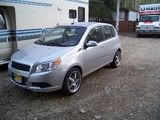Conclusions from the Washington State Transportation Center found here:
http://www.wsdot.wa.gov/research/rep...orts/551.1.pdf
1. Studded tires produce their best traction on snow or ice near the freezing mark and lose proportionately more of their tractive ability at lower temperatures than do studless or all-season tires.
2. The traction of studded tires is slightly superior to studless tires only under an ever-narrowing set of circumstances. With less aggressive (lightweight) studs being mandated, and with the advent of the new “studless” tire, such as the Blizzak, since the early 1990s, the traction benefit for studded tires is primarily evident on clear ice near the freezing mark, a condition whose occurrence is limited. For the majority of test results reviewed for snow, and for ice at lower temperatures, studded tires performed as well as or worse than the Blizzak tire. For those conditions in which studded tires provided better traction than studless tires, the increment usually was small.
3. The precise environmental conditions under which studded tires provide a traction benefit are relatively rare. The maximum frictional gain (in comparison to nonstudded (not studless) tires) is found for new studded tires on smooth ice, where they have been shown to provide up to 100 percent gain in certain tests. However, the relative frictional gain of studded tires diminishes or becomes negative on roughened ice, as the temperature drops, as the studs wear, or if the comparison is made with studless tires.
4. Traction performance can be characterized in many ways, including braking, acceleration, cornering, controllability, and grade climbing. Though all factors are important, the single best indicator of tire performance is braking distance and deceleration.
5. Studded tires reduce the difference in friction factor between optimum-slip and locked-wheel braking in comparison to non-studded tires. This may reduce the risk of drivers misjudging the necessary braking distance and may improve the braking potential for anti-lock brakes.
6. In one set of stopping distance tests in Alaska, studded, studless, and all-season tires performed nearly equally on snow, when averaged across several vehicles. On ice, stopping distances for studded tires were 15 percent shorter than for Blizzaks, which in turn were 8 percent shorter than for all-season tires.
7. In another set of tests in Alaska, studless Blizzak tires offered the best traction performance, especially for braking on both packed snow and ice in comparison to studded tires (which were second) and all-season tires (which were last).
8. The use of two studded tires on the front of a vehicle produced stopping traction results on snow and ice that were about halfway between the result of four studded tires and four all-season tires. However, other controllability penalties, such as yaw instability, should be considered.
9. On bare pavement, studded tires tend to have poorer traction performance than other tire types. This is especially true for concrete; for asphalt, there is little difference in stopping distance between studded and non-studded tires.
10. Tractive performance of studded tires is sensitive to stud wear. Studded tires may lose more of their tractive ability over time (from stud wear) than studless tires. When stud protrusion diminishes to 0.024 in. (0.6 mm), the frictional effect from the studs becomes negligible. Tire tread wear (on studded tires) has relatively little frictional effect if stud protrusion is maintained at 0.039 in. to 0.043 in. (1.0-1.1 mm).
11. A Norwegian study concluded that the use of studded tires tends to reduce the accident rate by a small amount – from 1 to 10 percent.
12. A number of driver behavior issues have been postulated that tend to affect the judgment of studded tire effectiveness. There is not consensus on these points: 1) drivers with studded tires care more about safety, hence they drive more safely, 2) they drive faster (because of a false sense of security or confidence), and 3) drivers with non-studded tires avoid driving when weather is severe.
13. Pavement rutting caused by accelerated wear from studded tires can cause the dangerous conditions of tramlining, hydroplaning on accumulated water in the ruts, excessive road spray, and premature damage to pavement markings.
14. The roughening of ice and pavement from studded tires provides a safety benefit for all vehicles (with and without studs) by helping to prevent formation of smooth, glare ice.
15. The cost of studless tires is significantly higher than studded tires—by
approximately 50 percent.
16. Studded tires increase fuel consumption by a small amount (~1.2 percent) over non-studded tires on bare roadways. But the other effects of unevenness, snow, and ice are far more significant than this factor and can increase fuel consumption by 15 percent.
17. Suspended particulate matter from pavement dust created by studded tires and noise from studded tires are health concerns in heavily traveled urban areas



 LinkBack URL
LinkBack URL About LinkBacks
About LinkBacks
 Reply With Quote
Reply With Quote

